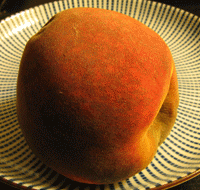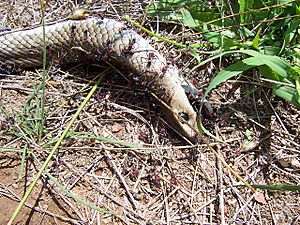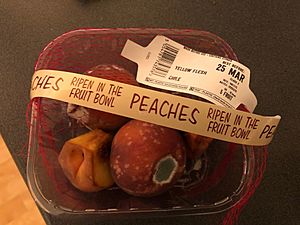Decomposition facts for kids
Decomposition, also known as rotting or decay, is what happens when living things like plants and animals die and break down. It also happens to any natural material, like food. This process is super important because it recycles nutrients back into the environment. When something decomposes, its parts are used as building blocks and energy by tiny living things that help break it down.
One whole group of living things, called fungi (like mushrooms and molds), are experts at decomposition. They are known as 'saprophytes' because they break down and absorb organic matter through their cell walls.
A big part of decomposition is done by microbes, especially tiny bacteria. You might also see maggots (which are insect larvae) eating dead flesh. When insects lay eggs, these maggots hatch and start feeding on the body's tissues.
Sometimes, decomposition can happen through non-living processes too. All natural materials slowly break down over time because they are not as stable as simpler, non-living materials.
Contents
How Animals Decompose
Decomposition starts the moment an animal dies. Two main things cause this:
- Autolysis: This is when the body's own internal chemicals and enzymes start breaking down its tissues.
- Putrefaction: This is when bacteria break down the tissues.
These processes release special compounds that create the strong, often unpleasant, smell of decaying animal tissue.
The main decomposers are bacteria and fungi. However, larger scavengers also play a big role if they can reach the body. These include insects, mites, and other animals. For example, carrion beetles, flesh-flies, and blow-flies (like green bottle flies) are common.
In places like North America, larger scavengers include coyotes, dogs, wolves, foxes, rats, crows, and vultures. Some of these animals even carry away and eat bones. In water, decomposition is done by bacteria, fish, crustaceans, fly larvae, and other scavengers.
How Plants Decompose
Plant matter breaks down in several steps. First, water washes away the easiest-to-lose parts. Then, the plant material physically breaks into smaller pieces. This gives more surface area for tiny microbial life to attach to and attack. For small dead plants, soil animals help with this. For larger plants, insects and fungi do most of the work.
After this, the plant detritus (which includes things like cellulose and lignin) is changed by microbes. Different parts break down at different speeds. For example, lignin, a tough part of wood, is very hard to break down. Only certain fungi, like black-rot fungi, can do it.
Wood decomposition is a complex process. Fungi bring nutrients to the wood from outside. This helps saproxylic insects (insects that eat wood) grow. These insects then help break down the wood even more, returning nutrients to the forest floor.
Warm temperatures speed up plant decay, no matter what the plant is made of. In most grasslands, things like fire, insects, termites, grazing animals, and animals moving through the grass are the main ways plants break down. Bacteria and fungi then do the rest of the decomposition.
When plants decompose, they always release carbon dioxide. In fact, decomposition releases over 90 percent of the carbon dioxide into the air each year.
Food Decomposition
The decomposition of food, whether plant or animal, is often called spoilage. This is a very important area of study in food science. Food decomposition can be slowed down by preserving it.
Meat spoils quickly, often in hours or days, if it's not treated. It becomes unappetizing, possibly poisonous, or can cause infections. Spoilage happens because bacteria and fungi, which are always present, start breaking down the meat. These microbes come from the animal itself, from people handling the meat, and from tools.
Meat can stay edible much longer if it's handled cleanly during production and processing. Also, proper food preservation and storage methods are key.
Food spoilage is caused by tiny organisms like bacteria, molds, and yeasts, along with the food's natural decay. These decomposition bacteria grow very fast in moist, warm conditions. If conditions aren't right, the bacteria can form tough spores. These spores wait until conditions improve to start growing and reproducing again.
How Fast Does Decomposition Happen?
The speed of decomposition depends on three main things:
- The physical environment (like temperature, moisture, and soil type).
- The amount and quality of the dead material.
- The type of microbial community present.
Decomposition is slow in very wet or very dry conditions. It happens fastest in damp, moist places with enough oxygen. Wet soils often don't have enough oxygen, which slows down microbe growth. In dry soils, decomposition also slows, but bacteria can still grow, even if plants can't. When it rains and soils get wet, many bacterial cells burst, releasing a sudden burst of nutrients.
Decomposition also tends to be slower in acidic soils. Soils rich in clay minerals usually have slower decomposition rates and more organic matter. Clay particles are small and can hold a lot of water. More water in soil means less oxygen, which slows decomposition. Clay minerals also stick to organic material, making it harder for microbes to reach. Disturbing the soil, like by tilling, can increase decomposition by adding oxygen and exposing new organic matter to microbes.
The quality and amount of material available to decomposers also greatly affects the speed. Substances like sugars and amino acids break down easily. These are called "labile" compounds. Cellulose and hemicellulose break down more slowly and are "moderately labile." Compounds that are very hard to break down, like lignin, are "recalcitrant."
Material with more labile compounds decomposes much faster. So, dead animals decompose faster than dead leaves, which decompose faster than fallen branches. As organic material in the soil gets older, its quality goes down. The easy-to-break-down parts decompose quickly, leaving more of the tough, recalcitrant material behind. Microbes also have tough materials in their cell walls, and these build up as microbes die, further reducing the quality of older soil organic matter.
Images for kids
-
A rotten apple after it fell from a tree
See also
 In Spanish: Descomposición para niños
In Spanish: Descomposición para niños






